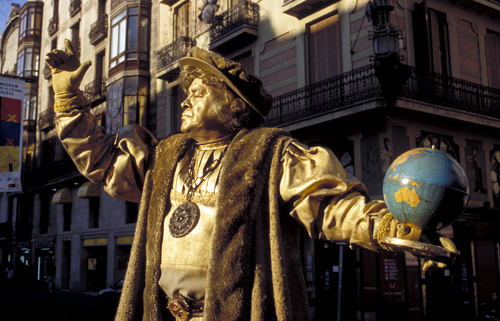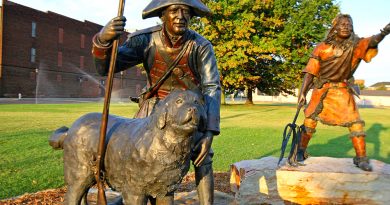Great Explorers: The Americas
Exploration of the New World began in earnest towards the end of the 15th Century following Christopher Columbus’ iconic voyage of 1492. Oddly enough, the colonisation of the Americas occurred almost by accident, with the majority of these voyages motivated by the desire to seek an alternative route to Asia and its lucrative natural resources. Discovering the New World by complete accident, a new age of discovery emerged as competing empires fought tooth and nail with the native populations and each other to secure domination of the Americas. In modern times, these continents are new centres of Western cultural imprints, the native populations essentially wiped out. The annexation by these explorers remains one of the most controversial processes in human history.
Leif Erikson
While his accomplishments are often eclipsed by the later ones of Christopher Columbus, Leif Erikson was in fact the first European to have set foot on North America. A Norse explorer hailing from Iceland, his feats preceded those of Columbus by over 500 years. He established a small settlement he named Vinland (for its plentiful grape-vine plants) in modern-day Newfoundland. He was the son of major Viking Erik the Red, who established the first Norse settlement in Greenland. While there were no permanent settlements in the New World, Erikson’s accomplishments are nonetheless considerable and far ahead of his time.
Christopher Columbus
The most successful and well-known figure of the Age of Exploration, Columbus, while not the first European to travel to the New World was responsible for its eventual colonisation. His four voyages across the Atlantic Ocean are almost legendary in terms of their historical significance, forming permanent links between Europe and the Americas. An Italian by birth, Columbus eventually settled in Spain and eventually convinced the Catholic monarchy to finance a westwards journey to reach the East Indies and profit from the increasingly flourishing spice trade. His first expedition arrived in the Americas in 1492 in modern-day Bahamas. He visited Cuba and established the first European colony in the Americas in modern-day Haiti. Returning home the following year, his discoveries sparked significant interest in the new ‘West Indies’, particularly due to the natives, flora and fauna he brought with him. His success saw a second voyage quickly financed and embarked upon. The intention of this second voyage was to establish permanent colonies and to spread Christianity amongst the Native population.
The second voyage saw visits to Dominica and the Virgin Islands. He established a number of settlements before returning home. The third voyage was dispatched with the intention of finding the continent near the islands he had already discovered. After a problematic voyage, Columbus arrived at the American in mainland in modern-day Venezuela whilst seeing the islands of Trinidad and Tobago. By the time of his fourth and final voyage, popular opinion of Columbus had declined and he was no longer in the good graces of the Catholic Church. He travelled to Martinique and to Santo Domingo and was stranded in Jamaica for an entire year. Eventually, he returned to Spain. He came into conflict with the crown upon his return, dying shortly thereafter. In modern times, Columbus is a polarising figure, drawing criticism for tyrannical treatment of native populations, including playing a role in the genocide of the Taino people. His name and influence extends throughout the modern Americas. The Columbian Exchange, the trade of flora and fauna between the New World and the Old World was instigated by Columbus. He played a hugely significant role in changing the face of the world as we know it.
Juan Ponce de Leon
Cutting his teeth on Columbus’ second expedition in 1493, Ponce de Leon quickly rose to the top of the military hierarchy and became one of Spain’s major conquistadors. Ponce de Leon carried out a number of expeditions, motivated in part by a search for a fabled ‘Fountain of Youth’. He colonised Puerto Rico, where he served as Governor and saw the burgeoning colony blossom into a highly profitable enterprise. He then proceeded to explore the Caribbean Sea, during which he became the first person to discover Florida. According to legend, he was searching for the Fountain of Youth, although modern historians dismiss this theory. He was eventually killed upon a second expedition to Florida in 1521, dying from his wounds upon arrival in Cuba.
Hernan Cortes
One of the most infamous figures in history, Cortes was the most important of Spain’s Conquistadors. Few details are available surrounding the minutiae of his life or his personality. Hailing from an inconspicuous background, he was enticed by the prospect of becoming wealthy from the riches of the recently-discovered New World. Cortes’ best-known action was his role in the annihilation of the Aztec Empire. He convinced Diego Velasquez, the conqueror and governor of Cuba to allow him to lead an expedition to Mexico, however, a suspicious Velasquez cancelled this commission, which Cortes ignored. Cortes allied with a tribe near his first settlement and travelled to the Aztec capital of Tenochtitlan, where he encountered the leader Montezuma II. Montezuma believed him to be a god and welcomed him into the kingdom. Cortes responded by kidnapping and holding him for a huge ransom. After briefly leaving to fight off an expedition sent by Valeasquez, during which he convinced the majority to join his ranks, he returned and laid waste to the city. In 1523, he was named the Governor of New Spain, but was deposed due to Spanish fears about his growing influence. He found his powers limited considerably. He explored Central America afterwards but was never restored to the peak of his powers. He eventually returned home, bitter and a shadow of his former self. Assessments of Cortez are difficult due to scant details surrounding his life and motivations. While there is an overwhelmingly damning majority due to his genocidal actions and influence in the colonisation of Latin America, there are some schools which feel that he was mistreated during his lifetime by his superiors.
Francisco Pizarro
Another major Conquistador, Pizarro is best known for his successful capture and colonisation of the Inca Empire, modern-day Peru. Pizarro did not make a name for himself until he was well into middle-age. He was in his late 40’s by the time he first arrived in the New World. He discovered the Empire and the land which he named Peru before returning home to gain permission from King Charles V to initiate a conquest of the region. He returned shortly afterwards and achieved the most significant feat in his life. Following a protracted period of conflict, Pizarro managed to capture the Inca King Atahualpa. He held him for ransom, demanding a large room to filled with gold and two others to be filled with silver. Despite complying with the orders, Atahualpa was executed regardless. Conquest of Peru was completed as Pizarro’s troops entered the capital of Cusco. He was eventually killed by the son of his former enemy Diego Almagro out of revenge for his father’s disgrace and execution. Pizarro was known for the improbability of his accomplishments, managing to defeat the Incas with relative ease despite the lack of resources and long distance from allies.
Francisco Vasquez de Coronado
One of the lesser-known Conquistadors, Vasquez de Coronado lead a major expedition from Mexico through the heart of the modern-day United States culminating in Kansas. The two-year journey was motivated by a desire to reach the elusive Cities of Cibola, a mythical metropolis. During his expedition, he became the first European to sight major landmarks such as the Colorado River and the Grand Canyon. Despite these accomplishments, his expedition was deemed a failure at the time and he died in relative ignominy, having various criminal charges levied against him. He had inflicted considerable damage upon the native Pubeloan population, a major criticism of his actions.
Henry Hudson
One of Britain’s best-known explorers of the New World, Henry Hudson made four separate expeditions to the Americas. He was motivated, like many of his contemporaries by the desire to find an alternative route to Asia through the West. His early life is almost a complete mystery. Following his rise to prominence, he opened up much of Northeastern America, with the Hudson River, Bay and Strait all named for him. His search for the Northwest Passage consumed him. On his final voyage, a mutiny broke out over argument of whether to continue the journey or to return home. Hudson and those loyal to him were sent away on a small boat. Hudson was never heard from again.
Hernando de Soto
One of the major Conquistadors, de Soto was known for his vast expedition deep into the heart of the modern-day United States. He played a major role in the conquest of Peru as one of Pizarro’s main captains. This made him a very wealthy man but he harboured an ambition of leading a colonising mission of North America, which he was granted. De Soto’s specific route remains somewhat ambiguous and is contested by historians. He is regarded as the first European man to cross the Mississippi River and progressed from Florida through the Southeast United States and embark westwards, likely reaching Arkansas as his final destination before embarking for home. De Soto himself, however, died at a location which remains a mystery. De Soto’s expedition, a failure in the eyes of the Spanish, played a highly negative role in exacerbating tensions between Europeans and Native Americans. Notably, his expedition exposed natives to a number of diseases and his undiplomatic, militaristic approach caused a number of fierce clashes.
Jacques Cartier
One of the major figures in the canon of French explorers, Jacques Cartier notably claimed Canada as a French territory and gave the country its name. He conducted three voyages to the New World during which he extensively explored the region surrounding the the Gulf of St. Lawrence, discovering Prince Edward Island in the process. The success of his first voyage prompted a second one during which he established a settlement in modern-day Quebec. Cartier’s discovery and exploitation of the Gulf of St. Lawrence proved to be highly influential as many subsequent explorers used it as a means of accessing the North American continent. Retrospective analysis of his relations with Native populations is somewhat mixed and dependent on circumstance. He was known for his high levels of competence and strong navigational capabilities.
John Cabot
One of the most important explorers of the New World, John Cabot was best known for being the first European explorer to arrive on coastal North America since the time of the Vikings. An Italian by birth hailing from Genoa, he made his name under the service of the British, commissioned to discover a new route to Asia and its riches by King Henry VII. Arriving in modern-day Newfoundland, which he believed to be Asia, he annexed it on the behalf of the British Crown. Cabot returned on a second expedition one year after his first voyage, with the intention of finding Japan. There is little evidence of his eventual fate, although most take the view that he arrived in North America but did not survive to return home.




